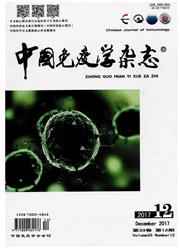

 中文摘要:
中文摘要:
目的:研究Th1趋化因子CXCL9/MIG、CXCL10/IP-10、CXCL11/I-TAC和Th2型趋化因子CCL22/MDC及其受体CXCR3、CCR4在大疱性类天疱疮(BP)皮损中的表达。方法:应用免疫组化方法检测30例BP患者皮损及20例正常皮肤中CX-CL9、CXCL10、CXCL11、CCL22、CXCR3和CCR4的表达。结果:BP皮损中4种趋化因子及其受体的表达均高于正常皮肤。其中,Th1趋化因子CXCL9、CXCL10和CXCL11及其受体CXCR3的阳性率分别为50%(15/30)、46.7%(14/30)、46.7%(14/30)和53.3%(16/30),Th2趋化因子CCL22及其受体CCR4的阳性率分别为66.7%(20/30)、56.7%(17/30)。正常对照中CXCL9、CX-CL10、CXCL11及其受体CXCR3的阳性率分别为10.0%(2/20)、10.0%(2/20)、15.0%(3/20)和15.0%(3/20),CCL22及其受体CCR4的阳性率分别为20.0%(4/20)和25.0%(5/20)。结论:Th1趋化因子CXCL9、CXCL10、CXCL11和Th2趋化因子CCL22及其受体CXCR3和CCR4在BP皮损中表达升高,提示它们可能在BP的发病机制中起一定作用。
 英文摘要:
英文摘要:
Objective: To investigate the expression of Thl chemokine CXCL9, CXCL10, CXCL11, Th2 chemokine CCL22 and their receptors in the lesions of bullous pemphigoid (BP). Methods: Imrnunohistochemical assay was performed to detect the expression of CXCL9, CX- CL10,CXCLll,CCL22 and their receptors CXCR3 and CCR4 in BP lesions and normal control skin. Results: CXCL9, CXCL10, CXCLll, CCL22, CXCR3 and CCR4 were overexpressed in BP lesions than those in normal control skin ( P 〈 0.01 ). The positive rates of CXCL9, CX- CL10, CXCL11 and CXCR3 in BP lesions were 50 % ( 15/30 ), 46.7 % ( 14/30 ), 46.7 % (14/30) and 53.3 % (16/30), respectively. The positive rates of CCL22 and CCR4 were 66.7% (20/30) and 56.7% (17/30). Conclusion: The overexpression of Thl chemokine CXCIB, CX-CL10, CXCL11, Th2 chemokine CCL22 and their receptors may play important roles in the pathogenesis of BP.
 同期刊论文项目
同期刊论文项目
 同项目期刊论文
同项目期刊论文
 期刊信息
期刊信息
